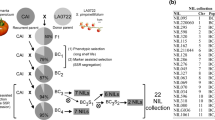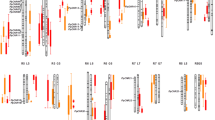Abstract
By relatively simple breeding procedures, seven different modifications of fruit and pedicel have been successfully transferred from wild tomatoes of the Galápagos Islands to large-fruited cultivars. Some of these traits, the majority of which are simply inherited, may have horticultural value. Such introgression from the wild forms is expedited by the remarkable freedom from barriers at any stage of the breeding processes.
Similar content being viewed by others
Literature Cited
Butler, L. 1936. Inherited characters in the tomato. II. Jointless pedicel. Jour. Hered.27: 25–26.
Hanna, G. C., A. Gentile, P. G. Smith, and L. F. Lippert. 1964. Recently developed vegetable varieties. Calif. Agr.18(3): 8–10.
Jenkins, J. A. and G. Mackinney. 1955. Carotenoids of the apricot tomato and its hybrid with yellow and tangerine. Genetics40: 715–720.
Joubert, T. G. La G. 1965. A third jointless gene in tomatoes. S. Afr. Jour. Sci.8: 571–582.
Mackinney, G., C. M. Rick, and J. A. Jenkins. 1954. Carotenoid differences inLycopersicon: hybrids of an unusual race ofL. pimpinellifolium. Proc. Nat. Acad. Sci.8: 695–699.
Mayr, E. 1963. Animal species and evolution. Harvard Univ. Press, Cambridge, Mass.
Rick, C. M. 1956. Genetic and systematic studies on accessions ofLycopersicon from the Galápagos Islands. Amer. Jour. Bot.43: 687–696.
—. 1963. Biosystematic studies on Galápagos tomatoes. Occ. Papers Calif. Acad. Sci.44: 59–77.
—, and L. Butler. 1956. Cytogenetics of the tomato. Advances in Genetics8: 267–382.
—, and P. G. Smith. 1953. Novel variations in tomato species hybrids. Amer. Nat.87: 359–373.
Schwanitz, F. 1957. Die Entstehung der Kulturpflanzen. Springer. Berlin.
Tal, M. 1965. Estimation of genetic differences betweenLycopersicon esculentum andSolanum pennellii. Ph.D. Thesis, Univ. of Calif., Davis, Calif.
Author information
Authors and Affiliations
Additional information
Various aspects of this work have been supported by grants from the National Science Foundation. The Galápagos parents were collected under the auspices of a grant from the Rockefeller Foundation. It is a pleasure to acknowledge the competent assistance of Dora G. Hunt and Dr. John E. Boynton; receipt of many invaluable collections from Sr. Miguel Castro, Conservation Officer, Charles Darwin Station, Galápagos, Ecuador; and analyses of fruit pigments by Dr. Gordon Mackinney, Department of Nutritional Sciences, University of California, Berkeley, California.
Rights and permissions
About this article
Cite this article
Rick, C.M. Fruit and pedicel characters derived from Galápagos Tomatoes’. Econ Bot 21, 171–184 (1967). https://doi.org/10.1007/BF02897867
Received:
Issue Date:
DOI: https://doi.org/10.1007/BF02897867




